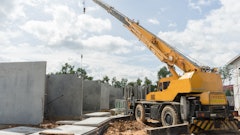
In the construction industry, we might not think of airports as a lucrative place to complete our work, but maybe we should. As of February 2020, there were over 19,600 airports and similar facilities in use in the United States. As of October 2019, around 133.3 billion U.S. dollars were spent on airport infrastructure in the North America. And that number is only going to go up.
The passage of the Infrastructure Investment & Jobs Act (IIJA) means that there will be $25 billion available for airport projects. Of that amount, $15 billion is distributed by formula over five years for grants to airports to use for their Airport Improvement Program (AIP).
That amount of money is double what is currently spent on airport projects now meaning this will be an area of substantial growth over the next few years.
More than half of all AIP funds go toward constructing or rehabilitating runways, taxiways and aprons. The best news of all? Over 85% of these pavements are currently constructed from asphalt, putting our industry in a great spot to be profitable from this legislation.
Airport Pavements vs. Highways
It's not really a secret that airport pavement construction is much different than highway construction so contractors who wish to work on these projects, need to be prepared and know what they're doing. Airport pavements need to support the massive amount of weight carried by airplanes so the mix and lay down methods are not the same as highway projects.
Airport pavement construction is also intense and expensive. Runways need to be shut down for the work causing disruption so work needs to be done quickly so the Federal Aviation Administration (FAA) requires airport pavements structures to be designed to support 20 years of aircraft traffic. They also have many pavement standards to help protect this investment by ensuring pavements last as long as possible with the least amount of maintenance.
There is a lot to learn and we want to help.
In this issue, we feature an interview with Mark Blow, senior regional engineer at the Asphalt Institute here. Blow has taught countless courses on the asphalt pavement construction of airport runways and gives us a rundown of some best practices for these projects. You can also learn how to attend one of the Asphalt Institute seminars on airport pavement construction. Worth it if you want to be able to compete for bids on these type of projects.
We also feature a project from Dunn Roadbuilders who completed reconstruction of an airport runway in just six days. This company has a lot of experience with these projects, but they had to start somewhere. The logistical challenges and time constraints of this project is definitely worth reading. You can see this project here.
There is a lot to learn about these type of projects, but the work is there and you should be too.




















